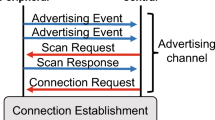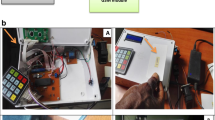Abstract
A radio frequency identification system can establish a communication between tags and readers through a wireless connection. Due to the optimized coverage of the environment, the readers are placed close to each other in this system and hence it is called dense reader environment. The very property of such an environment leads to increase in the probability of occurrence of reader-to-reader and reader-to-tag collisions which consequently come up with decrease in performance of the network. To solve this problem, many various protocols have been proposed of which centralized ones provide higher throughput. Our proposed method can reduce reader-to-reader collision through combining TDMA and FDMA mechanisms and benefiting from sift probability function and fairness. Furthermore, we found that distance comparison between two readers can reduce reader-to-tag collision as well. Our simulations indicate that the proposed method provides better throughput, average waiting time and fairness than existing ones. Our method also supports the mobility of the readers.













Similar content being viewed by others
References
Birari, S. M., & Iyer, S. (2005). PULSE: A MAC protocol for RFID networks. International Conference on Embedded and Ubiquitous Computing, 3823, 1036–1046.
Bueno-Delgado, M. V., Egea-Lopez, E., Vales-Alonso, J., & Garcia-Haro, J. (2009). Radio-frequency identification technology. In Handbook of enterprise integration (pp. 429–466).
Bueno-Delgado, M., et al. (2010). A comparative study of RFID schedulers in dense reader environments. In 2010 IEEE international conference on industrial technology (ICIT) (pp. 1373–1378). IEEE.
Bueno-Delgado, M. V., et al. (2013). A geometric distribution reader anti-collision protocol for RFID dense reader environments. IEEE Transactions on Automation Science and Engineering, 10(2), 296–306.
Bueno-Delgado, M. V., & Pavon-Marino, P. (2013). A centralized and aligned scheduler for passive RFID dense reader environments working under EPCglobal standard. Simulation Modelling Practice and Theory, 34, 172–185.
CEPT, U. (2005). Electromagnetic compatibility and radio spectrum matters (ERM); Radio frequency identification equipment operating in the band 865 MHz to 868 MHz with power levels up to 2 W; Part 1: Technical requirements and methods of measurement [Internet], Internet.
Eom, J.-B., et al. (2009). An efficient reader anticollision algorithm in dense RFID networks with mobile RFID readers. IEEE Transactions on Industrial Electronics, 56(7), 2326–2336.
ETSI, E. 302 208-1 Version 1.4. 1 2011.
Ferrero, R., et al. (2010). Fair anti-collision protocol in dense RFID networks. In 3rd international EURASIP workshop on RFID technology (EURASIP-RFID 2010) (pp. 101–105). Citeseer.
Ferrero, R., et al. (2014). Improving Colorwave with the probabilistic approach for reader-to-reader anti-collision TDMA protocols. Wireless Networks, 20(3), 397–409.
Ferrero, R., et al. (2013). Simulating reader-to-reader interference in RFID systems. In 2013 27th international conference on advanced information networking and applications workshops (WAINA) (pp. 1063–1069). IEEE.
Fu, L., et al. (2016). Optimal charging in wireless rechargeable sensor networks. IEEE Transactions on Vehicular Technology, 65(1), 278–291.
Galiotto, C., et al. (2012). Low access delay anti-collision algorithm for readers in passive RFID systems. Wireless Personal Communications, 64(1), 169–183.
Gandino, F., et al. (2009). Introducing probability in RFID reader-to-reader anti-collision. In Eighth IEEE international symposium on network computing and applications, 2009. NCA 2009 (pp. 250–257). IEEE.
Gandino, F., et al. (2011). Probabilistic DCS: An RFID reader-to-reader anti-collision protocol. Journal of Network and Computer Application, 34(3), 821–832.
Global, E. (2008). EPC radio-frequency identity protocols class-1 generation-2 UHF RFID protocol for communications at 860 MHz–960 MHz, version.
Golsorkhtabaramiri, M., et al. (2015). A reader anti-collision protocol for RFID-enhanced wireless sensor networks. Wireless Personal Communications, 81(2), 893–905.
Jamieson, K., et al. (2006). Sift: A MAC protocol for event-driven wireless sensor networks. In European workshop on wireless sensor networks (pp. 260–275). Springer.
Jiang, X., Liu, Y., Leng, Y., Liu, J., & Gan, Z. (2012). An efficient and secure RFID-based online monitoring system architecture for enterprise asset management. Journal of Convergence Information Technology, 7(21), 220–227.
Joshi, G. P., & Kim, S. W. (2008). Survey, nomenclature and comparison of reader anti-collision protocols in RFID. IETE Technical Review, 25(5), 234–243.
Klair, D., et al. (2009). On the energy consumption of pure and slotted aloha based RFID anti-collision protocols. Computer Communications, 32(5), 961–973.
Klair, D. K., et al. (2010). A survey and tutorial of RFID anti-collision protocols. IEEE Communications Surveys and Tutorials, 12(3), 400–421.
Leong, K. S., et al. (2005). The reader collision problem in RFID systems. In 2005 IEEE international symposium on microwave, antenna, propagation and EMC technologies for wireless communications (Vol. 1, pp. 658–661). IEEE.
Nawaz, F., & Jeoti, V. (2015). NFRA-C, neighbor friendly reader to reader anti-collision protocol with counters for dense reader environments. Journal of Network and Computer Applications, 49, 60–67.
Safa, H., et al. (2015). A distributed multi-channel reader anti-collision algorithm for RFID environments. Computer Communications, 64, 44–56.
Shih, D. H., Sun, P. L., Yen, D. C., & Huang, S. M. (2006). Taxonomy and survey of RFID anti-collision protocols. Computer Communications, 29(11), 2150–2166.
Shu, Y., et al. (2015). TOC: Localizing wireless rechargeable sensors with time of charge. ACM Transactions on Sensor Networks (TOSN), 11(3), 44.
Tay, Y., et al. (2004). Collision-minimizing CSMA and its applications to wireless sensor networks. IEEE Journal on Selected Areas in Communications, 22(6), 1048–1057.
Tian, Y., Cheng, P., He, L., Gu, Y., & Chen, J. (2016). Achieving collision-free communication by time of charge in WRSN. Mobile Networks and Applications, 21(3), 414–424.
Waldrop, J., et al. (2003). Colorwave: A MAC for RFID reader networks. Wireless Communications and Networking, 2003. WCNC 2003. 2003 IEEE (Vol. 3, pp. 1701–1704). IEEE.
Waldrop, J., et al. (2003). Colorwave: an anticollision algorithm for the reader collision problem. Communications, 2003. ICC’03. IEEE International Conference on, IEEE, 2, 1206–1210.
Zhang, L., Ferrero, R., Gandino, F., & Rebaudengo, M. (2013, December). Simulation and evaluation of the interference models for RFID reader-to-reader collisions. In Proceedings of international conference on advances in mobile computing & multimedia (p. 209). ACM.
Author information
Authors and Affiliations
Corresponding author
Rights and permissions
About this article
Cite this article
Rezaie, H., Golsorkhtabaramiri, M. A fair reader collision avoidance protocol for RFID dense reader environments. Wireless Netw 24, 1953–1964 (2018). https://doi.org/10.1007/s11276-017-1447-8
Published:
Issue Date:
DOI: https://doi.org/10.1007/s11276-017-1447-8




